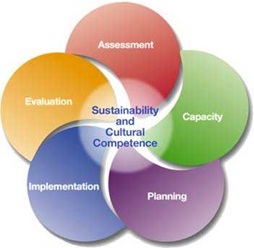 MAPP’s work follows the Strategic Prevention Framework of assessment, capacity building, planning, implementation, and evaluation while incorporating sustainability and cultural competence in each step.
MAPP’s work follows the Strategic Prevention Framework of assessment, capacity building, planning, implementation, and evaluation while incorporating sustainability and cultural competence in each step.
We also focus more on environmental strategies rather than individual strategies. Environmental strategies view the community as a set of persons engaged in shared social, cultural, political, and economic processes (Holder, in press). This perspective takes into account the fact that individuals do not become involved with substances solely on the basis of personal characteristics. Rather, they are powerfully influenced by a complex set of factors in the environment, such as the rules and regulations of the social institutions to which they belong, the norms of the communities in which they live, the mass media messages to which they are exposed, and the accessibility of alcohol, tobacco, and illicit drugs.
Individual strategies focus more on providing information, skills training, and opportunities for personal development through a variety of programs, including school-based curricula, mentoring, and peer education and counseling. The goal of such efforts is to reduce the probability of substance abuse by changing characteristics of individuals.
Environmental strategies have many advantages over individualized strategies which include:
- Broader reach. Compared to individually focused prevention, which seeks to reduce individual risk by intervening and creating change one person at a time, strategies focused on the environment have the ability to reach entire populations and reduce collective risk (Holder, in press).
- More lasting effects. Environmental approaches have the potential for long-term, as well as short-term, effectiveness. The synergistic effects of environmental barriers to use, coupled with widespread normative change, may result in the creation of a substantially changed system that offers fewer opportunities and inducements to use substances.
- Ease of maintenance and cost-effectiveness. Environmental approaches have the benefits of being comparatively easy to maintain and perhaps less costly than strategies directed at individuals.
